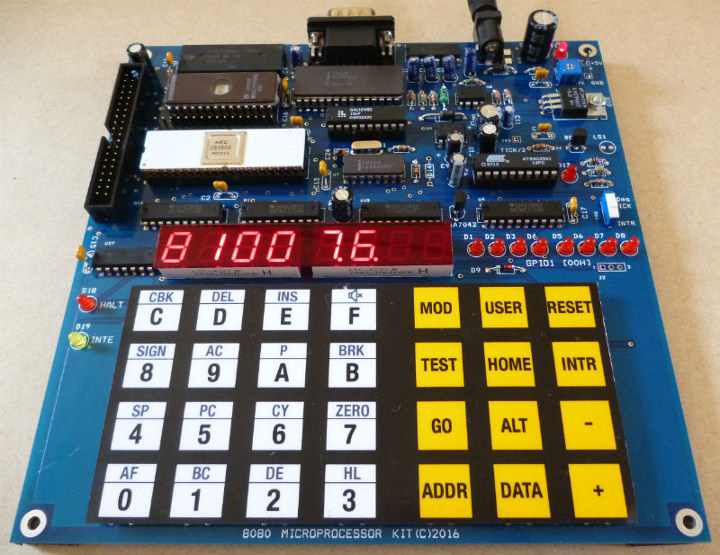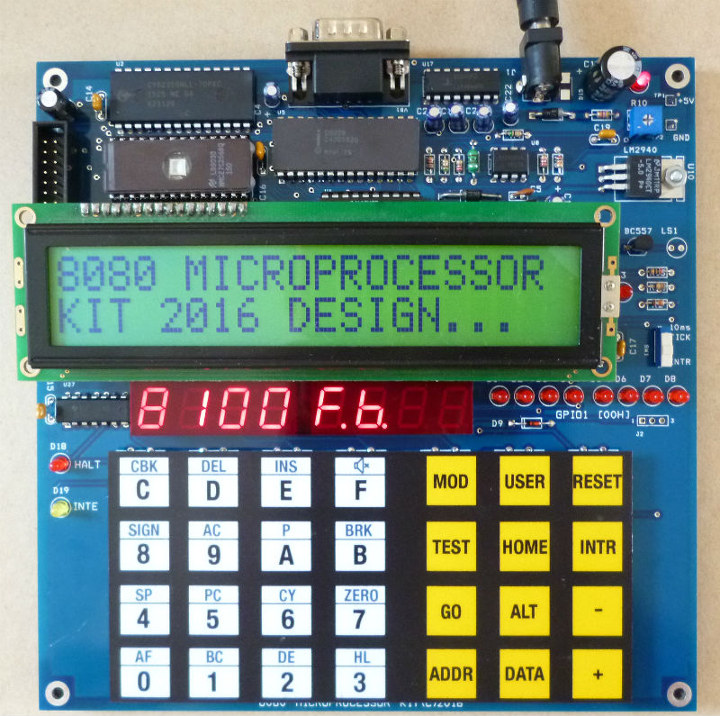Intel 8080 processor was released in April 1974, Motorola 6802 in 1976, and people in their late 40’s, 50’s or older may have experimented with those more than 40 years.
People may still have those at home, but surely it’s not possible to purchase those in 2019 if suddenly you’ve got that nostalgia feeling getting at you, right? Apparently, it is, as Wichit Sirichote, an associated professor at the Department of Applied Physics in King Mongkut’s Institute of Technology, in Bangkok, Thailand has designed a few development kits based on those older processors.

Let’s take the 8080 devkit as an example to check out the features of such kits:
- CPU – NEC 8080 CPU clocked at 2.048MHz
- Memory & Storage – 32KB RAM, 32KB EPROM
- Memory and I/O decoder chip – GAL16V8D PLD
- Oscillator – 8224 chip with Xtal frequency of 18.432MHz
- Bus controller – 8228 chip with RST 7 strobing for interrupt vector
- Display – 6-digit 7-segment LED display
- Keyboard – 28 keys
- RS232 serial port — Software-controlled UART 2400 bps 8n1
- Debugging LED – 8-bit GPIO1 LED at location 00H
- Tick – 10ms tick produced by 89C2051 available for time trigger experiments
- Text LCD interface – direct CPU bus interfaced text LCD
- Expansion header – 2x 20-pin header
- Misc – KIA7042 reset chip for power brownout reset; HALT and INTE bit indicator LEDs
- Power conversion – +12V and -5V power supplied via on-board MC34063 DC/DC converter and Intersil ICL7660
- Power consumption — 500mA @7.5V via external AC adapter
More details about the kit, including some sample code in assembly can be found on the project page.
If you did get started many years with another platform, Wichit Sirichote has a choice of other development kits based on relics of the past:
- CDP1802 Microprocessor Kit Build the Vintage COSMAC CDP1802 kit.
- Intel 8086 Microprocessor Kit Build the popular x86 based microprocessor kit with the 8086 CPU.
- Motorola 6809 Microprocessor Kit Build the 8-bit microprocessor kit with the 6809 CPU.
- Motorola 68008 Microprocessor Kit Build the 32-bit microprocessor kit with the 68008 CPU.
- Intel 8088 Microprocessor Kit Build the 16-bit microprocessor kit with a popular 80C88 CPU.
- 8051 Microcontroller Kit New design 8051 single board with 7-segment and hex keypad.
- Motorola 6802 Microprocessor Kit Back to 1976, 6802 Microprocessor.
- Z80 Microprocessor Kit Easy use with MPF-1 commands compatible, Z80 kit.
- 6502 Microprocessor Kit Back to classic CPU with MOS technology 6502 CPU.
- 8085 Microprocessor Kit. Nice design with smaller size PCB of MTK-85 kit.
I personally got started with a ZX-81 computer and then an Intel 8086 PC in the early 90’s so maybe I’m not that old after all 😉
You’ll find all the information about the microprocessor and microcontroller training kits on Mr. Sirichote’s website. There’s no purchase link on the website, but I heard about the projects via Rick Lehrbaum who wrote about his experience with the 8080 kit, and explains that you can contact Mr Sirichot by email (available on his website) if you’re interested in ordering one of his microprocessor kits.

Jean-Luc started CNX Software in 2010 as a part-time endeavor, before quitting his job as a software engineering manager, and starting to write daily news, and reviews full time later in 2011.
Support CNX Software! Donate via cryptocurrencies, become a Patron on Patreon, or purchase goods on Amazon or Aliexpress





